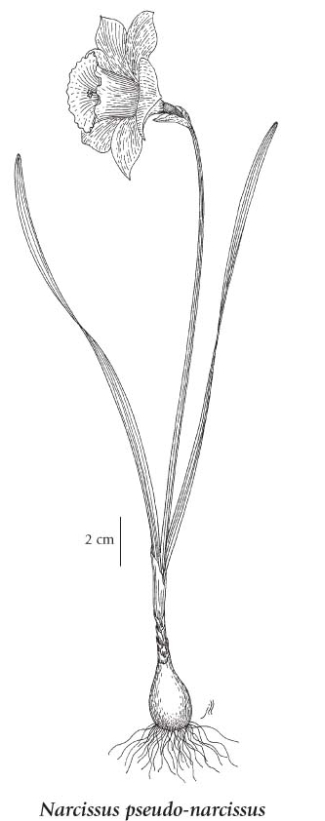Narcissus pseudonarcissus L.
daffodil
Liliaceae
Introduction to Vascular Plants
daffodil
Liliaceae
Introduction to Vascular Plants
Photograph click to collapse contents
© Diane Williamson (Photo ID #6604)
Photo details
View all photos for this taxon.
Species Information click to expand contents
General:
Perennial herb from an egg-shaped bulb 2-3 cm long, often with bulblets; flowering stems 20-40 cm tall, more or less compressed, 2-edged, smooth.
Leaves:
Basal leaves few to several, linear, erect, 12-35 cm long, 5-12 mm wide, flat to somewhat channelled, glaucous, smooth, the margins entire; stem leaves lacking.
Flowers:
Inflorescence of solitary, terminal, horizontal or drooping to ascending, short-stalked flowers, the stalks 3-10 mm long, issuing from a membranous tubular bract; flowers typically pale yellow, 3-6 cm long, of 6 similar segments fused at the base into a 1- to 2.5-cm long tube that spreads to the oblong or egg-shaped, ascending, wavy or twisted tepals, the trumpet-like crown (the corona, rising from between the segments and the stamens) about as long as the tepals, deep yellow, frilly at the mouth; stamens 6, shorter than the flowers; pistil 1, 3-chambered; ovaries inferior.
Fruits:
Capsules, egg-shaped to nearly globe-shaped, 1-2.5 cm long; seeds several to many.
Notes:
Probably not truly naturalized, but long persisting and multiplying vegetatively by bulblets. Most of the plants found apparently naturalized in BC are probably hybrids or cultivated forms of this species and not the wild species itself.
Illustration click to expand contents

If more than one illustration is available for a species (e.g., separate illustrations were provided for two subspecies) then links to the separate images will be provided below. Note that individual subspecies or varietal illustrations are not always available.
Illustration Source: The Illustrated Flora of British Columbia
Ecology click to expand contents
Ecological Framework for Narcissus pseudonarcissus
The table below shows the species-specific information calculated from
original data (BEC database) provided by the BC Ministry of Forests and Range.
(Updated August, 2013)
The table below shows the species-specific information calculated from
original data (BEC database) provided by the BC Ministry of Forests and Range.
(Updated August, 2013)
| Site Information |
Value / Class |
||
|
Avg |
Min |
Max |
|
| Elevation
(metres) |
1 | 1 | 1 |
| Slope
Gradient (%) |
1 | 1 | 2 |
|
Aspect (degrees) |
0 | ||
| Soil
Moisture Regime (SMR) [0 - very xeric; 4 - mesic; 8 - hydric] |
7 | 7 | 7 |
| Modal
Nutrient Regime
Class |
D | ||
| #
of field plots species was recorded in: |
2 | ||
| Modal
BEC Zone Class |
CDF | ||
|
All BEC Zones (# of stations/zone) species was recorded in |
CDF(2) | ||
|
Source:
Klinkenberg 2013
|
|||
Habitat and Range click to expand contents
Mesic to moist fields, edges of forests, roadsides and waste places in the lowland zone; rare garden escape on S Vancouver Island, the Gulf Islands and the lower mainland; introduced from Europe.
Status Information click to expand contents
Synonyms click to expand contents
Synonyms and Alternate Names:
Narcissus pseudo-narcissus L.